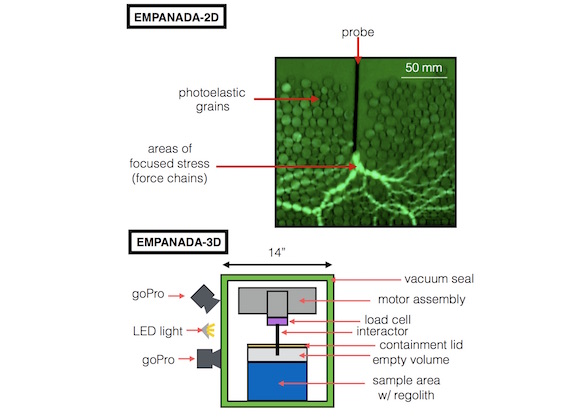EMPANADA: Ejecta-Minimizing Protocols for Applications Needing Anchoring or Digging on Asteroids
PI: Karen Daniels, Jonathan Kollmer (Co-I), North Carolina State University
PI: Karen Daniels, Jonathan Kollmer (Co-I), North Carolina State University

- TA04 Robotics, Tele-Robotics and Autonomous Systems
- TA07 Human Exploration Destination Systems
Protocols to minimize ejecta from interactions with planetary regolith in a low-gravity environment are critical for the safety and proper operation of experiments (either human or robot) on the surfaces of objects such as Near-Earth Asteroids where the surface gravity is often less than 0.001g. EMPANADA will consist of 5 interaction chambers based on the existing PRIME platform (see T0154), each of which is a unique experiment. Several modes of data collection will be utilized: contact forces via photoelasticity, force load on probe, and ejecta volume.
Four chambers (EMPANADA-3D) will comprise and utilize simulated regolith; one chamber (EMPANADA-2D) will perform photoelastic measurements of interparticle forces. The slow, flexible probes, the interaction assembly and the photoelastic response imaging system are the new technologies tested. All systems will be at TRL-4 before the parabolic flights and at TRL-7 after completion of the flight test plan.
Potential end-users include planetary scientists and other granular materials scientists interested in studying granular mechanics at variable microgravity levels, as well as users interested in understanding regolith behavior for exploration or ISRU purposes.
Technology Details
-
Selection DateREDDI-F1-17A (Nov 2017)
-
Program StatusActive
- 1 Parabolic
Development Team
-
PIKaren Daniels
-
PI Organization
-
Co-IJonathan Kollmer
-
Co-I Organization
-
SponsorNorth Carolina State University

